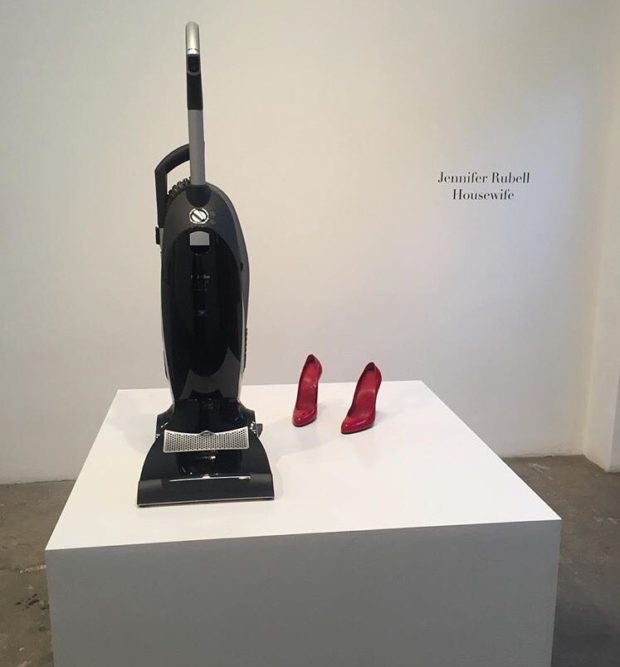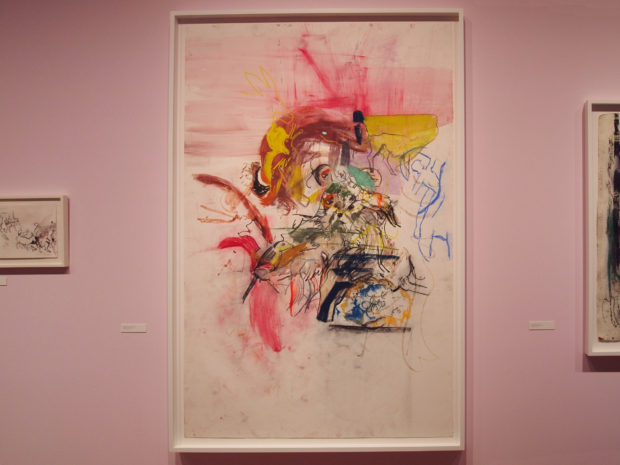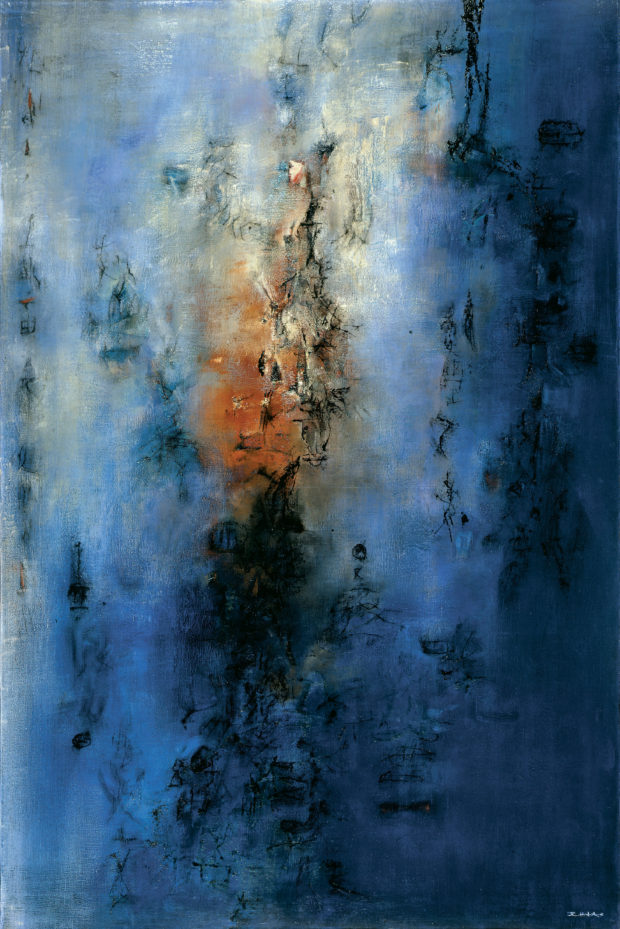In early November, 2022, participants arrived at Korean Art Week in Boston and Hanover, MA, to attend a conference organized by the Korea Foundation, Dartmouth… Continue Reading 2022 Korean Art Week: Between Past and Future is Now
Posts tagged as “review”
Jennifer Rubell’s Housewife, an installation at the Sargent’s Daughters gallery on the Lower East Side, attempts a conceptual history of modern femininity. In the simplest terms, the show is a meditation on the seeming universality of white, middle-class femininity. However, to critique Rubell’s stark visual vocabulary in this way fails to acknowledge that her work nevertheless touches a certain comprehensive psychological experience, which is both explicit and all-inclusive. From the 1950s housewife to contemporary dating and the difficulties of being a modern woman in the workforce, Rubell’s four pieces – Pedestal, Vessel, Partition Paintings, and Threshold – visualize the precarious nature of a femininity defined and circumscribed by others.

Three steps into the gallery space and the viewer is confronted by Pedestal, an industrial-quality vacuum cleaner placed next to a polished pair of red patent-leather heels fitted atop a heavy square platform. The glaring absence of the female form (the immediate assumption being that the empty space is, in fact, female), registers instantaneously. The effect is an invitation for the viewer to come closer, to slip on the heels, to grip the vacuum and fill that empty space. Although no apron or string of pearls is provided, the associations Rubell creates resonate with clarity. The piece references the commodified feminine ideal of the 1950s housewife who vacuums in her heels, has a hot meal on the table by six pm, and is ready for romance every night. However, because Rubell empties out that visual space, the viewer subconsciously fills it with her own form, which in return highlights the falsity and psychological dangers inherent in such mediating feminine perfection.
Tucked away in SoHo, New York, The Drawing Center is a small museum founded by Martha Beck in 1977, explicitly dedicated to the medium of drawing. For the last few years, the creative minds behind The Drawing Center’s events and exhibitions have been working towards pushing beyond the traditional understanding of the term drawing, and opening it up to various applications and interpretations. Cecily Brown: Rehearsal, organized by the chief curator of the museum, Claire Gilman, is one such exhibition. It calls the viewer to contemplate the medium of drawing; from its materiality to its role in the artistic process of an acclaimed artist, Cecily Brown, which as a result creates a sense of intimacy throughout.

Brown is a British artist known for her tactual paintings, for which she draws influence ranging from old masters to the expressionism of the 50s. Drawing is a lesser known part of Brown’s practice and has not been seen before in the scale and context of a solo museum exhibition. The works on display inform on Brown’s practice by giving the viewer the opportunity to observe how the artist visits existing drawings again and again, each time unpacking something new until, as she notes, she understands it completely. In a talk that took place in the museum, Brown discussed how her drawings are fairly independent of her painting practice, serving a purpose of their own. The works in Cecily Brown: Rehearsal were selected, among other reasons, so as to accentuate this special role in her overall practice.
CUNY’s James Gallery at The Center for the Humanities ushers in the fall semester with an exhibition based on Alison Knowles’s 1967 conceptual work The House of Dust. The show seeks to encompass the many limbed and generative nature of Knowles’s artwork by showing how it continues to stimulate other artists to explore its themes of translation, permutation, intentionality and inclusivity, bringing to light the work’s enduring relevance.
The House of Dust is a computer generated poem written in the programming language FORTRAN, which generates verses by randomly combining elements from four lists pre-determined by Knowles: each verse consists of four components including, and always beginning with, “a house of,” followed by a location, then a material, and finally a category of inhabitants. The poem repeats after 400 verses. In 1969, based on one of the verses, “A HOUSE OF PLASTIC/ IN A METROPOLIS/ USING NATURAL LIGHT/ INHABITED BY PEOPLE FROM ALL WALKS OF LIFE” Knowles constructed an actual “house” in Chelsea. The house was moved to Burbank, California when she took a teaching position at CalArts in 1970. Knowles also orchestrated several other projects using computer programs, involving students and community members with her house as the nexus.

1955
Oil on canvas
76 3⁄4 × 51 1⁄8 in. (195 × 130 cm)
Private collection, Switzerland
©Zao Wou-Ki ProLitteris, Zurich. Photography by Dennis Bouchard
At the entrance of the exhibition floats Zao Wou-ki’s painting Hommage à Chu Yun—05.05.55 (1955), a large canvas cloaked in fluid patches of startlingly limpid aquamarine, rust, and warm cream. The abstract work appears to conceal something underwater. Perhaps it is the ancient Chinese poet of the title, who, after being exiled, drowned himself in the Miluo River. The concentration of reddish color in the center hints at an object, yet the iridescent ripples make it difficult to identify.
No Limits: Zao Wou-ki, currently on view at the Asia Society Museum, is the artist’s first-ever retrospective in the U.S. Zao (1921-2013) is perhaps best known as the Chinese painter who moved to Paris after World War II, where he worked alongside the French Informel painters, while also maintaining a dialogue with the Abstract Expressionists in New York. Zao was not singular in his global career: many post-war painters enthusiastically communicated with an international network of artists and traveled around the world. The exhibition curators Dr. Melissa Walt, Dr. Ankeney Weitz, and Michelle Yun characterize modern abstract painting as defined by this “dynamic cross-cultural circulation of ideas and images.”

Nowhere does art feel more global than at the biennials and exhibitions that happen at such regular intervals that their devotees can confidently book their hotel tickets up to five years in advance. Certainly this is true at Documenta 13 in Kassel, Germany—a place with no particular history of strong artistic production in its own right, albeit a site with a very significant role in history itself. Yet in this global arena (this year’s Documenta includes physical or conceptual sites in Kassel, Kabul, Alexandria/Cairo, and Banff in Canada), a theme amongst the disparate works is a sense of place, a groundedness within the local—within the issues of the artist’s particular time and place—and one that is often framed within the larger historical scope of war. Though one theme among many (the exhibition included nearly 200 artists), this investigation of specific, localized moments in cultural and political history strikes a particular chord in Kassel, a tiny city smack in the center of Germany that was badly damaged by Allied bombs during World War II. The exceptional quality of the art on view and the panoply of locations from which they came make the associations, possible through the works’ juxtaposition, all the more striking and layered.


